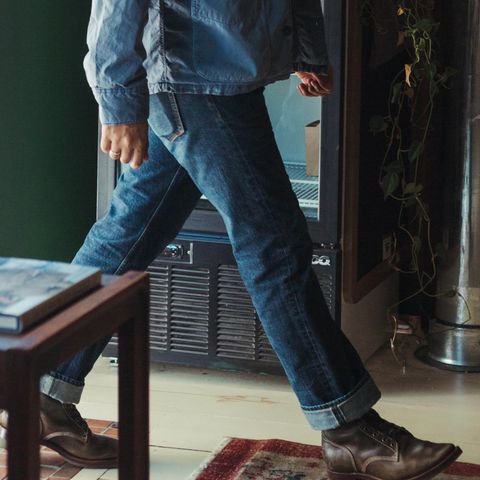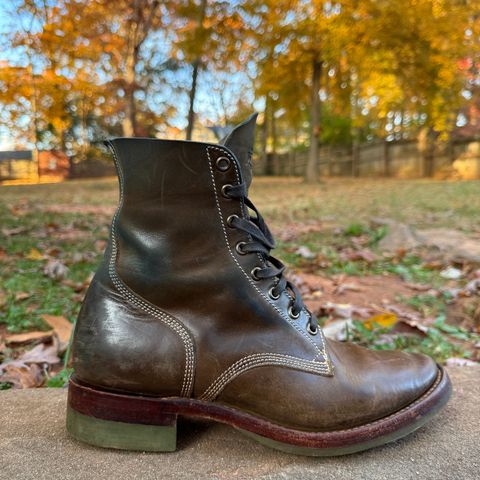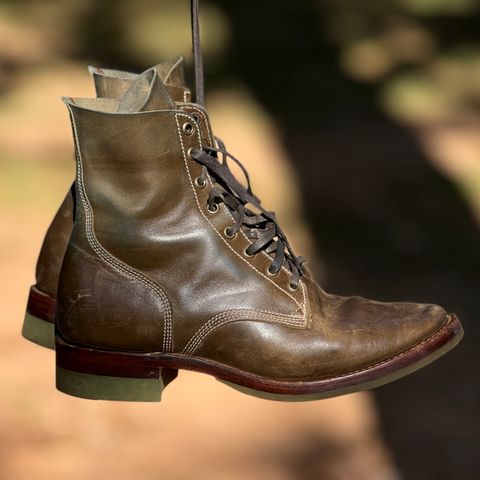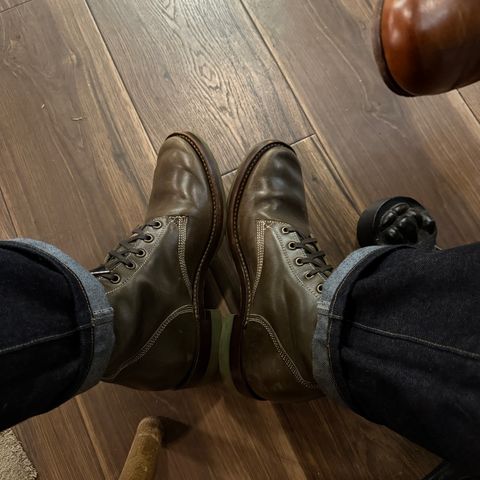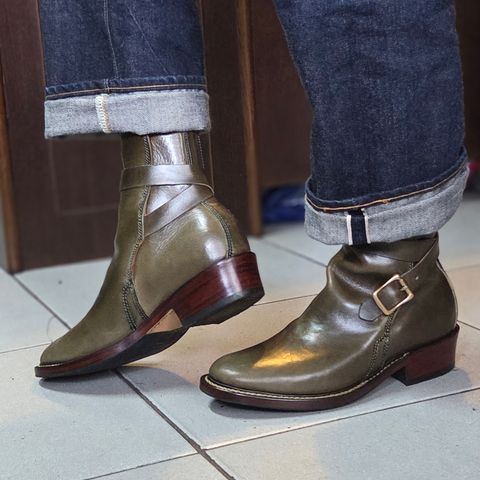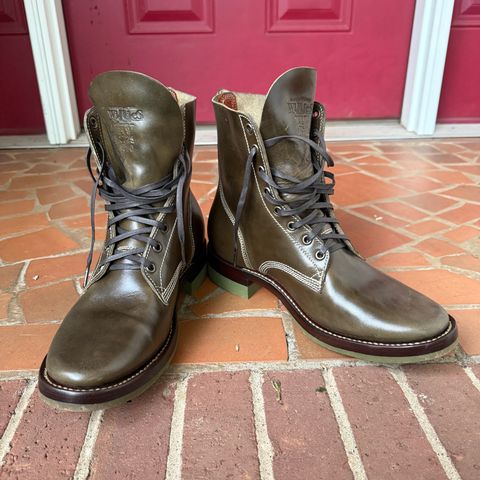About
Maryam Olive Horsebutt is a distinctive vegetable-tanned leather that combines the exceptional durability of horsebutt with a sophisticated olive green color inspired by the Mediterranean landscape of Tuscany. This premium leather showcases Maryam Tannery's mastery of color work, creating a rich olive tone that captures the essence of Italian olive groves while maintaining the superior characteristics that make horsebutt leather legendary among discerning leather enthusiasts.
About
Maryam Olive Horsebutt is a distinctive vegetable-tanned leather that combines the exceptional durability of horsebutt with a sophisticated olive green color inspired by the Mediterranean landscape of Tuscany. This premium leather showcases Maryam Tannery's mastery of color work, creating a rich olive tone that captures the essence of Italian olive groves while maintaining the superior characteristics that make horsebutt leather legendary among discerning leather enthusiasts.
Tannery Heritage and Color Philosophy
Maryam Tannery's location in Santa Croce sull'Arno places it at the heart of Tuscany's renowned leather district, surrounded by the olive groves and natural landscapes that inspire their color palette. The development of olive-colored leather reflects the tannery's deep connection to its Tuscan environment, where olive cultivation has been central to the regional identity for centuries. This connection between traditional craftsmanship and local natural heritage informs both the technical approach and aesthetic vision behind Maryam's olive horsebutt leather.
The tannery's centuries-old experience in vegetable tanning provides the foundation for creating complex colors like olive, which require careful balance between dye penetration and natural leather characteristics. Using traditional tanning methods with natural tannins from trees, combined with precise color application techniques, Maryam achieves olive tones that complement rather than mask the natural beauty of horsebutt leather.
Olive Color Characteristics
The olive color in Maryam horsebutt leather captures the sophisticated green-brown tones found in mature olive fruits and foliage. This complex color combines elements of green, brown, and subtle gray undertones to create a rich, earthy appearance that evokes the Mediterranean countryside. The olive hue provides a distinctive alternative to traditional brown and black leather colors while maintaining the timeless appeal that makes it suitable for both casual and formal applications.
The specific formulation of Maryam's olive color creates depth and variation within the leather surface, with subtle tonal differences that become more apparent as the leather ages and develops patina. This color complexity ensures that olive horsebutt leather maintains visual interest throughout its lifespan, with the aging process enhancing rather than diminishing the original color character.
Horsebutt Foundation Excellence
The horsebutt sections selected for olive treatment represent the finest examples of this exceptional leather type, featuring the incredible density and tight fiber structure that distinguish horsebutt from other leather varieties. While these sections don't meet the specific requirements for shell cordovan production, they possess all the durability, strength, and unique tactile qualities that make horsebutt highly sought after for demanding applications.
The full-grain surface of the horsebutt provides an ideal foundation for olive coloring, with the dense fiber structure ensuring even color penetration while maintaining the leather's natural texture and character. This combination of superior base material and expert color application creates a leather that performs exceptionally while displaying beautiful visual characteristics.
Vachetta Processing and Color Integration
Maryam's vachetta treatment for olive horsebutt involves barrel dyeing that allows the olive color to penetrate deeply into the leather structure while preserving the smooth, matte appearance characteristic of this processing method. The vachetta approach creates a soft hand feel that complements the olive color's sophisticated appearance, resulting in leather that appeals to both tactile and visual senses.
The integration of olive color through the vachetta process ensures that the color becomes an intrinsic part of the leather rather than a surface treatment, providing color stability while allowing for natural aging and patina development. This deep color integration means that even as the leather surface evolves through use, the olive character remains consistent throughout the material.
Patina Development in Olive Leather
Olive-colored vegetable-tanned leather develops distinctive patina characteristics that enhance its natural beauty over time. The complex color foundation of olive provides a rich canvas for patina development, with aging processes deepening and enriching the original color rather than fundamentally changing it. As natural oils, sunlight, and use patterns influence the leather, the olive tones become more nuanced and develop greater depth.
The patina development in olive horsebutt typically enhances the warmer brown undertones within the color, creating gradual shifts that add richness and complexity to the overall appearance. High-wear areas may develop slightly different color characteristics than less-used sections, creating subtle variations that add to the leather's individual character.
Environmental Factors and Color Evolution
The olive color responds beautifully to environmental influences that drive patina development in vegetable-tanned leather. Sunlight exposure can intensify certain aspects of the olive tone while softening others, creating gradual color evolution that reflects the item's exposure history. Natural oils from handling contribute to the development of luster and depth within the olive color, while environmental moisture and temperature variations influence the overall aging process.
The Mediterranean inspiration behind the olive color means that this leather often appears most natural when exposed to the same environmental conditions that influence actual olive trees—moderate sunlight, natural air circulation, and seasonal variations in humidity and temperature.
Applications and Style Versatility
Olive horsebutt leather excels in applications where distinctive color and exceptional durability are both priorities. The sophisticated olive tone works particularly well in outdoor and casual footwear, where the earthy color complements natural environments while the horsebutt durability handles demanding conditions. Premium boot manufacturers value this leather for creating distinctive products that stand out from traditional brown and black offerings.
The versatile nature of olive color makes it suitable for leather goods that bridge casual and formal contexts. Accessories such as belts, wallets, and bags in olive horsebutt provide unique alternatives to conventional colors while maintaining the timeless appeal necessary for long-term use and enjoyment.
Care and Color Maintenance
Caring for olive horsebutt leather focuses on maintaining the leather's health while preserving the distinctive color characteristics. The vegetable-tanned nature of the leather means it responds well to traditional leather conditioning products, but care should be taken to use treatments that won't alter the olive color or interfere with natural patina development.
The olive color's stability through the vachetta processing means that routine care won't significantly change the color appearance, allowing owners to maintain their leather goods without concern about color alteration. Regular conditioning with appropriate products can enhance the olive color's depth and richness while ensuring the leather remains supple and healthy.
Seasonal and Cultural Connections
The olive color creates natural connections to seasonal cycles and cultural traditions associated with olive cultivation and Mediterranean life. This leather often appears most vibrant during autumn months when its earthy tones complement the natural environment, while maintaining year-round appeal through its sophisticated color balance.
The cultural associations with olive cultivation—sustainability, tradition, and connection to the land—extend to leather goods made from olive horsebutt, creating products that carry symbolic meaning alongside practical functionality. This cultural dimension adds depth to the ownership experience, connecting users to centuries of Mediterranean tradition and craftsmanship.
References
Maryam Tannery Official Website - Company overview, tanning processes, and heritage information
RM Leather Supply - Maryam Horse Butts - Official North America distributor specifications
CRUXdeluxe - Olive Horsebutt Jodhpurs - Real-world example of Maryam olive horsebutt use in boot manufacturing
BuyLeatherOnline - Maryam Tannery Products - Maryam product range and color options including olive variants
Moore & Giles - Olive Tanned Leather - Olive tanning process using olive leaves and sustainability aspects
Buckleguy.com - Valdibrana Italian Olive Green Vachetta - Italian vachetta leather characteristics and olive green color properties
Thirteen50 Leather - Natural Vegetable Tanned Patina - Detailed explanation of vegetable-tanned leather patina development
Von Baer - Leather Patina Complete Guide - Comprehensive guide to leather patina formation and characteristics
Popov Leather - What is Leather Patina - Technical explanation of patina development in vegetable-tanned leather
Medium - Visit to Maryam Tannery - Firsthand account of Maryam tannery operations and processes
Galen Leather - Vegetable Tanned Leather - Quality characteristics and benefits of vegetable-tanned leather
